Keep Moving
It is difficult to think about the films of Nicolás Pereda without also taking stock of their place within an economy of festival cinema, film journalism, and an alternative circuit of international art-film production and distribution, one that identifies and anoints its rising stars rather quickly. Pereda is now 29 years old, has completed an astonishing amount of professional-level film work (four features, a featurette, and a widely lauded short film) in just over four years, and is now receiving retrospective screenings of his work at a point that could not even charitably be called "mid-career." What's going on here?
We've seen this sudden burst of attention before, of course. The most recent recipient of this kind of wunderkind critical focus was Filipino experimentalist Raya Martin, whose prodigious output in a relatively short amount of time rivaled Pereda's, even if some of his more outré efforts, like the four-plus hour video Now Showing (2008), eventually lightened the bandwagon a bit. A while before Martin, a substantial amount of cinephilic attention zeroed in on Argentinian ethno-minimalist Lisandro Alonso, whose La libertad (2001) sliced through the clutter of critical opinion like its near-silent protagonist, Misael, hacking down a tree. But by the time Alonso had evolved, producing the more urbane, less feral Liverpool (2008), a lot of early supporters were done with him. The point being, neither filmmaker has been particularly well served by the window of hype that initially ushered them onto the scene. And both continue to make vitally important work. (Still, they've fared better than, say, Jean-Paul Civeyrac or Alain Guiraudie, whose moment in the limelight has been little more than a flicker. Always something new in France . . .)
There are obvious explanations for why intellectual film criticism and festival programming, those areas of cinema culture charged with deepening appreciation and generating lasting standards of judgment, may have gotten sidetracked of late into the business of snap decisions and the following of fashions, for good and ill.On the festival side of things, the shifts over the past two decades are well documented. Corporate sponsorship is no longer understood to be the province of benign, tax-deductible image building. Instead, charitable contributions are more commonly seen as a part of active "branding," which entails a much more active hand in shaping the very culture that corporate sponsors are underwriting. Likewise, there is a certain mode of festival cinema that, once it has traveled through various vetting procedures—grant panels, funding bodies, programming selection committees, and editorial boards—can have many of its unwieldy formal appendages lopped off, resulting in work that simply demands to be anointed, because its inherent qualities are, to all intents and purposes, a self-fulfilling, bureaucratic prophesy. This "festival mode" can often produce great art. But it can also generate convergent, rather than divergent, forms of expression. This is quite easy to observe from the outside looking in (e.g., the Sundance labs), perhaps harder to see from the inside out (e.g., the Hubert Bals Fund). What's more, the continual drive, within all points of this apparatus (production, exhibition, criticism) to lionize new talent can often leave filmmakers stranded at a certain point in their career, just when they ought to be exercising full mastery over their craft.
I begin with this lengthy excursus not as a means to avoid interrogating the films of Nicolás Pereda, but as a way of contextualizing their arrival on the scene, because it is my hope that we will still be talking about them in five, 10, even 20 years. Pereda's work is promising, if a bit uneven. But this is precisely what we ought to expect from a young filmmaker working at this accelerated pace. If he is anointed too soon, however, I do fear that he will be the man of the moment, and that moment will pass all too quickly, just as he is ready to become a career artist. I find it quite intriguing, for example, and not entirely inaccurate, that writers on Pereda, such as Robert Koehler and Haden Guest, have compared his work to the likes of Jia Zhangke, Tsai Ming-liang, and Pedro Costa. Like all of these filmmakers, Pereda tends to work within a certain set of formal parameters, with a select group of actors, and he treats each subsequent film, to an extent, as an opportunity to explore permutations of that same basic set of parameters. Pereda's work tends toward recombinant themes and performances, an unobtrusively distanced camera position, and a mise-en-scène characterized by even lighting and a muted color palette. Like his perpetual leading man Gabino Rodríguez (he of the gently sloping, Timothy Carey visage), Pereda is a director of seemingly easy, even slack prepossession that conceals total control. From his very first film, Where Are Their Stories? (2007), the director seemed to have his fundamental style in place, to an almost preternatural degree.
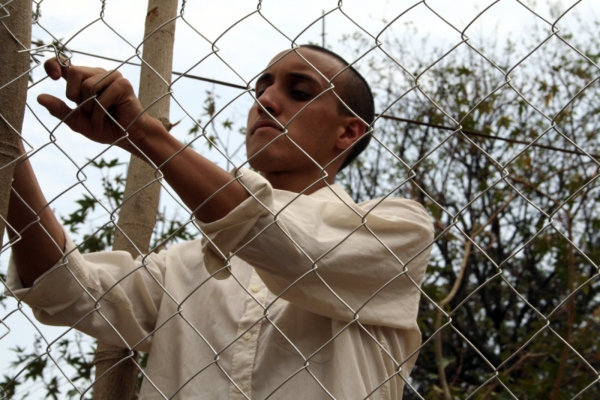
Gabino Rodríguez in Where Are Their Stories?, directed by Nicolás Pereda
But Costa, Tsai, and Jia are also telling examples in terms of the political pitfalls of critical and programmer attention. If there is one filmmaker whose plight could be considered, not a cause, but perhaps an unconscious instigator for the last 10 to 15 years of accelerated art-hype, it would probably be Costa. Although he had many pockets of ardent fans throughout the world prior to his international breakthrough in 2006 with Colossal Youth, Costa's recognition as one of the pivotal filmmakers of the mid-'90s through the '00s has been largely a retroactive correction. As hip-hop fans say, Pedro Costa was the most "slept on" director of the decade, and now there seems to be a hyper-vigilance not to miss another master in our midst. On the other hand, Jia and Tsai are well-established masters, even if some early adopters seem to find less value in Jia's recent historical excavations (2008's 24 City, 2010's I Wish I Knew), and many are ready to write Tsai off altogether, based on aggressively personal, audience-unfriendly excursions such as The Wayward Cloud (2005) and Visage (2009). Pereda may understand that inclusion in such august company is a dual-edged sword.
Becoming "branded" too early on results in a career trajectory that requires careful planning. How will you get the films made when you're no longer the rising star or, in the case of mid-career masters like Tsai, when some deem you to be no longer sufficiently "you"? (It reminds one of Geffen's lawsuit against Neil Young, for handing in an album that wasn't considered "representative music.") By contrast, Pereda's work, produced within a compressed span of time, is highly "representative." Four of Pereda's five features comprise a body of work of remarkable clarity and coherence, which speaks both to Pereda's talent and his unique set of circumstances. Born in Mexico City, an MFA graduate of Toronto's York University, Pereda is a dual citizen of Mexico and Canada. Each of his films has been a Canadian-Mexican co-production, drawing funding from both national tills. His most recent completed feature, Summer of Goliath (2010), also garnered funding from Rotterdam's Hubert Bals Fund, adding Dutch money to the mix. So Pereda's sudden omnipresence, while merited by a slew of highly accomplished films, cannot be separated from this web of financial support, which is somewhat more developed than that of other film artists at comparable points in their careers.
Pereda's debut feature, Where Are Their Stories?, is in many respects his most formally ambitious work, while maintaining tangible connections to the socioeconomic realities of contemporary Mexico, connections that will become more abstract in later films. Stories opens in a dank farmhouse bedroom where Vicente (Gabino Rodríguez, one of Pereda's two axiomatic actors) tends to his grandmother (Juana Rodríguez), droplets of leaking pipe water falling from the ceiling onto her face. We soon learn that Vicente's abuelita maintains a wide swath of farmland with her grandson's help, and that her two grown sons plan to sell the farm out from under her and take the money back home to San Antonio. (Pereda, the Mexican-Canadian, quite logically posits the U.S. as the vortex in the middle whence much bad business emanates.) Pereda carefully details Vicente's movement through various levels of legal and political indifference, and his eventual trip to the city to meet with a lawyer (who he can't afford) and to see his mother (Teresa Sánchez, Pereda's other perennial lead), who works as a live-in maid for a haute-bourgeoisie couple. Comparisons with Tsai are not off base; Pereda displays a knack for blocky, linear compositions that turn wry comedic situations into displays of power. But in his elegant use of light and matte finishes, color modulation, and subtly recessed space, Pereda has more in common with the muted formalism of Mohsen Makhmalbaf and especially Jafar Panahi. What's more, Where Are Their Stories? operates via what we might call a centripetal organization. We begin with Vicente, but Pereda continues to open the story outward, returning us to earlier focal points while adding others.
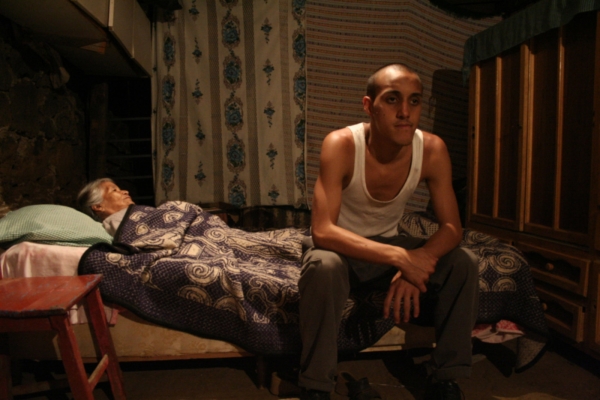
Gabino Rodríguez in Where Are Their Stories?
The two works that followed, 2009's Juntos (aka "Together") and Perpetuum Mobile, are Pereda's finest works to date. They function as a kind of diptych, the former on video, the latter on film. Both reflect a different set of foregrounded possibilities in working with the same basic narrative and formal materials—Gabino (Rodríguez) versus his exhausted mother (Sánchez), in conflict with his girlfriend Luisa (Luisa Pardo, an excellent all-round foil), and bereft over the loss of Junto, his dog; all of this within a lower-middle-class apartment setting characterized by chronic disrepair verging on total dilapidation. In Juntos, houseguest/freeloader Paco (Francisco Barreiro) lets Gabino's dog escape, an incident that merely becomes the depressive emotional backdrop for everything else that occurs. The majority of the (in)action, however, involves a bizarre series of manipulations with water. The family melts cups of ice to drink. Buckets are filled from the sink for toileting and dishwashing. A desperate Paco slurps down the dog bowl. The fridge stops working—a perfect "couples bickering" scene has Gabi and Luisa argue over whether or not the fan is running—and the crisis escalates. In time, Pereda reveals what's up in this Tsai-in-reverse plumbing scenario. It seems that all the water in the apartment comes out of every tap at a boiling hot temperature. To avoid burns (even on the toilet), all water must be allowed to cool prior to use. Pereda's joke is a clever one. Not only is this problem preposterous. (Has any apartment dweller ever suffered from a surfeit of hot water?) It also alludes to his own "cool," detached style of filmmaking, one in which all events require an unusual degree of filmic time in order to reach room temperature, to even out any potentially "hot" events that might upset the balance.
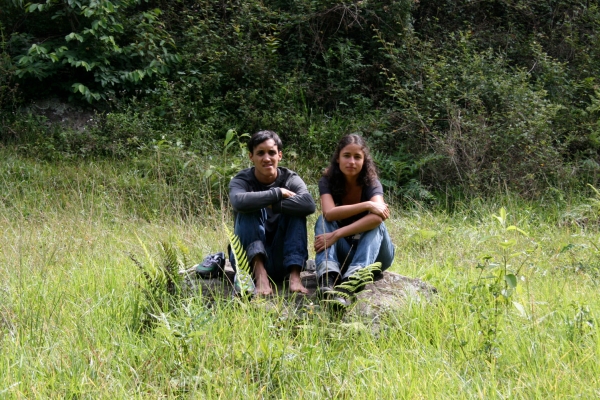
Gabino Rodríguez and Luisa Pardo in Together, directed by Nicolás Pereda
Perpetuum Mobile features a scene between Gabino and Luisa in which she describes a dream that matches specific plot points of Juntos. In this respect, the two films are adjacent to one another, parallel existences (not unlike, say, the TV show Fringe), neither of which is better or more self-actualized, neither more given to flights of fancy. If Juntos is a formal examination of couplings and displacements (in particular the need to allow water, or relationships, to sit and steep prior to proper use), Perpetuum Mobile is Pereda's somewhat explicit riff on the Jarmuschian/Kaurismäkian picaresque, funneling those directors comic Bressonianism through his own set of preoccupations. Paco and Gabino are independent movers working the streets of Mexico City with the crappiest-looking clapboard panel truck you've ever seen. Gabi's mother (Sánchez, of course) constantly berates him for not getting up early, not helping clean up, not replenishing her pet birds' water supply, etc. Meanwhile, she continually prepares special Sunday dinners for her older son Miguel, a middle manager with no further use for his déclassé family. (Spoiler: Miguel is the family Godot.)
Whereas Stories followed a centripetal pattern, and Juntos was about displaced states of matter, Perpetuum Mobile (as per its title) examines the ramifications of objects moved or in motion. Pereda has fashioned a kind of Newtonian comedy, in Bresson's materialist vein. (Think of Bresson's symphonic movement of objects: the wallets in Pickpocket, the contraband in A Man Escaped, the forged bank note in L'Argent.) The movers encounter multiple random cross-sections of urban Mexican life through their various assignments (an elderly couple on the brink of divorce; an evicted grad student; a young woman leaving her gay BFF to move in with her new boyfriend). At each point, it is the weight of stuff, the lugging back and forth of accumulated belongings that permits Pereda the time for elaborating the human sociology on display. And, in the case of the grad student, his predicament allows Gabino and Paco to rip him off. Then, his "homeless" pile of junk becomes Paco's, then Gabi's, and then finally Gabi's grandmother's (Juana Rodríguez again), at least until her own slow, methodical movement—the ponderous, delicate maneuvering of the impaired self that awaits all of us—complicates the plan. Then she, too, becomes another form of cargo.
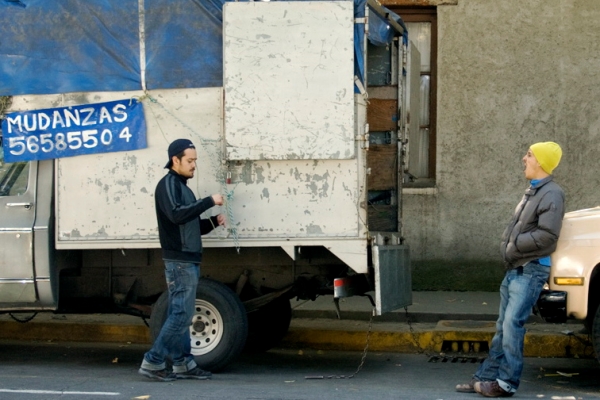
Perpetuum Mobile, directed by Nicolás Pereda
The organicism and conceptual rigor of Pereda's first three features would be difficult for any young filmmaker to sustain, but to a large extent Pereda has, with one notable exception. At the risk of being a philistine, Pereda's least narrative-driven effort, and the one least of a piece with the remainder of his output, is undoubtedly his least successful work to date. The experimental video featurette All Things Were Now Overtaken by Silence (2010) has all the proper ingredients for an inquiry into the creative process. In fact, the presence of said ingredients is a bit too blatant, resulting in a film that feels tailor-made for a particular segment of the museum/cinematheque coterie. All Things is a slow, methodical, black-and-white piece that "documents" the meticulous production of an austere performance of the poem "Primer sueño," by Sor Juana Inéz de la Cruz. The poem, generally considered Sor Juana's masterwork, is performed by Mexican actor-director Jesusa Rodríguez, while Pereda slowly moves the filmmaking apparatus around her and the set in order to generate dramatic effects of light and shadow. In practice, All Things is very much a cross between Apichatpong Weerasethakul's short film Worldly Desires (2005) and Costa's similarly high-key, black-and-white Ne change rien (2009). While Pereda's desire to eschew his formulas is deeply admirable, All Things is an anomaly—an idiosyncratic film without a signature.
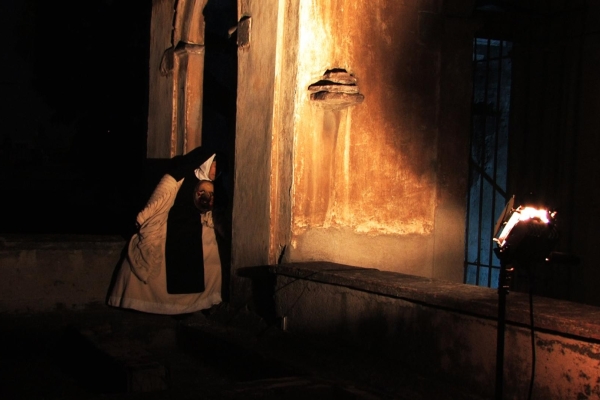
All Things Were Now Overtaken by Silence, directed by Nicolás Pereda
By contrast, his two remaining films, the 18-minute short Interview With the Earth (2008) and its feature-length expansion, Summer of Goliath, represent a more harmonious reconciliation of All Things' fiction-documentary experimentation with the attention to formal structure and narrative organization evident in the first three Pereda features. However, Goliath's combination of self-seriousness and open-form dispersal is ultimately unsatisfying. It bears the marks of an artist struggling to absorb and reinscribe the shibboleths of the official film culture that has so vigorously embraced him. It is almost as though, on some unconscious level, Pereda sensed that he could be taken only so seriously as a maker of wry comedies, regardless of their prodigious skill. (There is some truth to this. Jia and Costa tend to be held in an awe not quite extended to, say, Kaurismäki or Roy Andersson.)
Summer of Goliath begins with semi-fictionalized, talking-head interviews against a black background. Sixteen-year-old Oscar (Oscar Saavedra Miranda) has been nicknamed "Goliath" because he is believed to have murdered his girlfriend. The off-camera interviewer (Pereda) asks various siblings and cousins whether they think Goliath did it or not. Much like Junto's disappearance, the Goliath murder becomes a mere backdrop, seldom referred to again. We see Oscar and his (real-life) brothers, Nico and Amalio, wandering through the woods now and again. In time, the younger boys are interviewed regarding the absence of their father. (This is a scene excerpted wholesale from Interview With the Earth.) Meanwhile, Gabino returns home from the army, with a fellow soldier (Harold Torres), the two of them intimidating random citizens and making maricón jokes. The main action of the film, however, belongs to Teresa, who is going out in search of the paterfamilias. He, it seems, has left her, his occasional male lover, and the rest of the clan to run away with a younger woman. Teresa becomes progressively unglued over the course of the film, carrying a suitcase of the man's clothes, first to sell, then to deposit in the creek, and finally to cling to in the muddy filth, groaning like a wounded animal.
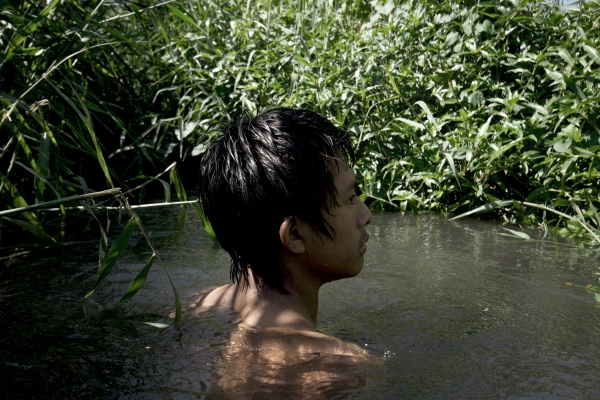
Summer of Goliath, directed by Nicolás Pereda
Whereas his previous films managed to locate an anchor point and spin outward, maintaining a structure within which more and more points of view and formal ideas could be explored, Goliath never articulates its multiple strategies. One can detect a pervading sense of grief and mental waywardness, the signs of a community in the throes of total dissolution. But beyond this, Goliath moves in fits and starts, as though Pereda were just throwing any idea against the wall to watch it stick. Complicating matters, this is, along with Interview, his first fully rural film, set in the countryside of Huilotepec. With Pereda's insistence on ill-fitting documentary material, a Gabino character much more defined by blithe machismo, and Teresa coming on less as the solid center and more like an earthy Medea, there's a pervading feeling that Goliath is making a bit of a fetish of its non-urban characters. Are they really meant to be less witty, and closer to their rawest emotions, than their Mexico City counterparts? Ultimately, Summer of Goliath seems less like a Nicolás Pereda film and more like one made by a selection committee.
Fortunately, Pereda's next project, Los mejores temas (Greatest Hits), returns to Mexico City, and the Gabino/Teresa characters the filmmaker developed in Juntos and Perpetuum Mobile. In it, Gabino is a merchant of pirate CDs who must memorize hundreds of songs for his playlists. (This is likely a throwback to one of Goliath's best scenes, in which Teresa makes Gabino memorize a long letter to his father, for no apparent reason. This, in turn, played like a comedic variation on Ventura's recitation of the letter based on Robert Desnos's poem in Costa's Colossal Youth.) I strongly suspect Los mejores temas will represent a return to form for Pereda. But lest I seem to be advocating that this complex artist "stick to his brand," allow me to conclude by noting that although Summer of Goliath may be something of a noble failure, Pereda's early sketch for that film, Interview With the Earth, was a full-fledged success. In restricting itself to a closely attended set of formal challenges, this film demonstrates the mastery with which Pereda can combine fictional and documentary modes.
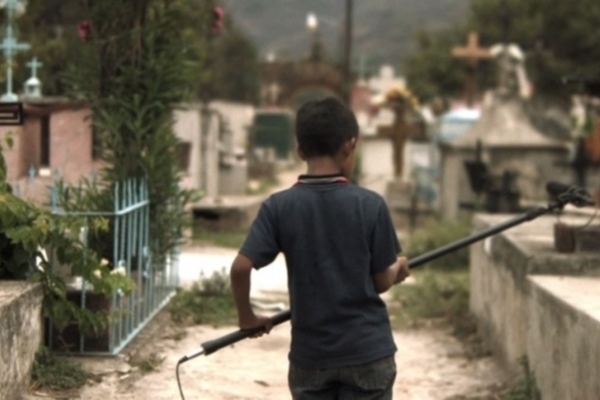
Interview With the Earth, directed by Nicolás Pereda
Besides the aforementioned discussion between the two brothers regarding their absent father, Interview With the Earth is primarily about how Nico and Amelio have dealt with an accident in which a friend of theirs, David, fell from a mountain and died while the three of them were collecting cacti. At first, Pereda interviews Nico about David, and how they were best friends. "Why don't you see him anymore?" Pereda asks. "I just don't," Nico replies, suggesting that they had a falling out. In time, the two boys explain the accident, how they witnessed it, feel responsible even though David insisted on going after a high cactus, and how David's mother blames them (Nico especially) for her son's death. Interspersed with this interview material, Pereda has the boys' mother (Eufracia Miranda) and Juana Rodríguez discussing how a chicken should be tied up and sacrificed at the site of David's death. We witness the fitful, circular hopping of a scrawny, one-legged chicken, but no slaughter. Instead, the final shot shows Nico walking away from Pereda's camera with a boom mic. Instead of a meaningless blood offering, Interview With the Earth sacrifices the illusion of pure cinematic truth. Pereda pays tribute to David's memory by demonstrating that mourning is more complex than either fiction or documentary alone can render. Interview With the Earth shows what Pereda can do with hybrid forms when, like his comedic fictions, they are driven by a sense of purpose and rigor. ![]()
LATEST ARTICLES
-20140814-173707-thumb3.jpg)
Fighting Words
by Imogen Sara Smith
posted August 12, 2014

Fighting Words, Part 2
by Imogen Sara Smith
posted August 20, 2014

On the Margins: The Fil…
by Andrew Chan
posted August 12, 2014

Robin Williams: A Sense…
by David Schwartz
posted August 12, 2014
 Keep Moving
Keep Moving
KEYWORDS
Nicolás Pereda | Retrospective | film criticism | Pedro Costa | Canadian cinema | Mexican cinemaTHE AUTHOR
Michael Sicinski is a film writer and teacher based in Houston, Texas. He is a frequent contributor to Cinema Scope, Cineaste, and GreenCine Daily.
More articles by Michael Sicinski
